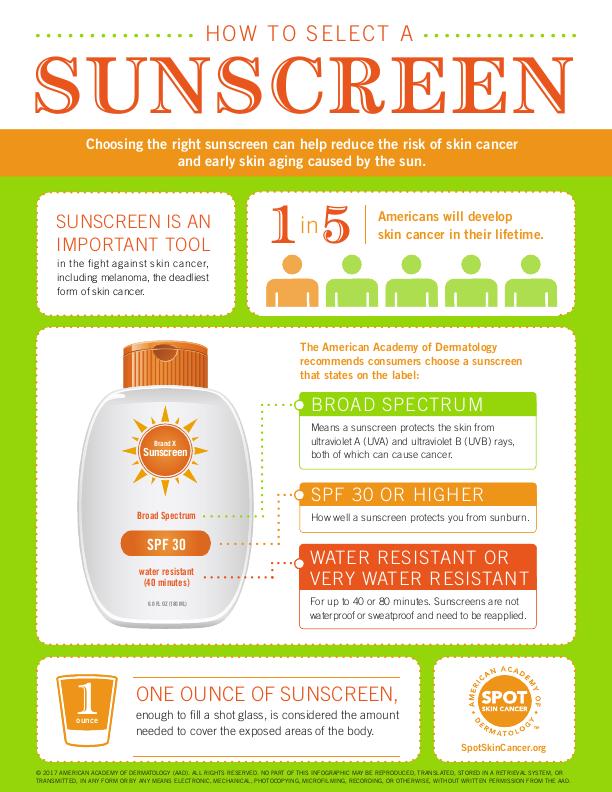Looking to revamp your skin routine for summer? Start with sunscreen, the holy grail product of the season.
Sunscreen should be worn by everyone over the age of 6 months, every day — especially in the summer. Increased exposure to the sun can cause unpleasant signs of early aging, such as wrinkles and sunspots.
It can also lead to skin cancer.
“Sunscreen’s going to really protect those harmful rays from affecting your skin and possibly causing predisposition to skin cancer in your future,” said Nicole Pink, DNP, APRN, CNP, a dermatology specialist at the Sanford Bemidji 1611 Anne St. Clinic in Bemidji, Minnesota.
Here’s what to know about choosing a sunscreen from Sanford Health skin care experts.
How to choose a sunscreen
Enlarge

Image by American Academy of Dermatology
When looking for sunscreen, reach for one with a sun protection factor (SPF) of 30 or greater.
“They do go all the way up to 100 SPF, but in reality, 30 SPF is all a person needs to protect their skin from those harmful rays,” said Dr. Pink.
Dr. Pink recommends finding a broad-spectrum sunscreen that will block both UVA and UVB rays. Ingredients in sunscreen can also affect how long it takes the product to become effective.
Sunscreens with zinc oxide or titanium dioxide work immediately after application, while spray sunscreens that contain oxybenzone and avobenzone need to be applied 30 minutes prior to sun exposure.
For patients who prefer the spray, make sure to rub it in after applying. That’s why Dr. Pink prefers to have patients use a topical lotion if possible.
“I have seen so many instances where patients have used the spray and they miss spots because it’s windy or they’re outside on the lake. Then they end up with this really goofy looking sunburn that’s got patches and blotchy spots.”
Sunscreen and your skin care routine
Once deciding on a sunscreen, make it a part of your daily routine. A basic routine should consist of washing your face, moisturizing, and applying sunscreen — in that order.
“The very last product to ever be applied should always be the sunscreen, because you want to make sure that that’s on the top layer of the skin,” Dr. Pink said.
She suggests getting a dual sunscreen-moisturizer: “That way it’s all in one product and you don’t have to worry about another product to apply.”
To be fully effective, sunscreen should be reapplied every two hours. Remembering to reapply can be difficult, even for dermatologists.
“The biggest misconception or problem that people have that can cause burning is they forget to reapply or they extend the time in which they reapply,” Dr. Pink said.
Other ways to protect from sun
Sunscreen isn’t the only way to protect from the sun. Jocelyn Frohm, M.D., practices dermatology at Sanford Dermatology Clinic in Sioux Falls, South Dakota. She says it’s important to use other methods of sun protection in addition to sunscreen.
“Wearing wide-brim hats, sunglasses, clothing with UPF, and seeking shade” are a few more ways to protect your skin, she said.
Wide-brim hats and sunglasses can cover areas that are easy to forget when applying sunscreen.
“The number one place I see people forget is the scalp,” Dr. Pink said. “They think because they have hair that they’re protected and really, we see a lot of sunburns affecting the top of the scalp.”
Don’t forget to cover your eyes, she said. “I’ve had patients with skin cancer in their eye, so it’s really important that we have patients also protect their eyes.”
Other commonly forgotten areas include the hands, feet and ears.
“I would definitely advise to make sure you have a good layer of sunblock covering your hands as well as your feet,” Dr. Pink said. “Those are kind of the most common spots as well as the knees. They tend to stick out and can really easily get sunburned.”
Treating a sunburn
Despite the best efforts, sunburns happen. Nicole Soto, M.D., who practices dermatology at Sanford North Dermatology in Bismarck, North Dakota, and Dr. Pink explain what to do if you get one:
- Drink water. “Your skin is basically depleted of all of its natural water that’s onboard, so drinking a lot of water is absolutely essential,” Dr. Pink said.
- Take ibuprofen or Aleve. “A sunburn can be treated in the first 24 to 48 hours with an NSAID (non-steroidal anti-inflammatory drug) such as ibuprofen and Aleve, which seems to reduce the extent of the injury,” Dr. Soto said.
- Moisturize. “Apply moisturizers every day to help reduce the peeling,” Dr. Soto said.
- Apply aloe vera. Aloe vera gel can help “alleviate some of the pain associated with a sunburn,” Dr. Pink said. Dr. Soto recommends keeping it in the refrigerator for added effect.
- Know when to see a doctor. If the sunburn develops into something more serious, it’s important to seek help from a primary care doctor. “If a patient were to develop major burns or open sores, that would be something they should see their doctor for,” Dr. Pink said. “Really bad sunburns can actually turn into infections and really become problematic.”
Learn more
- Spot and prevent skin cancer ahead of time in the sun
- Keep your family cool and safe in the summer heat
- Skin cancer gives patient plenty of Mohs surgery experience
…
Posted In Bemidji, Bismarck, Dermatology, Healthy Living, Sioux Falls
